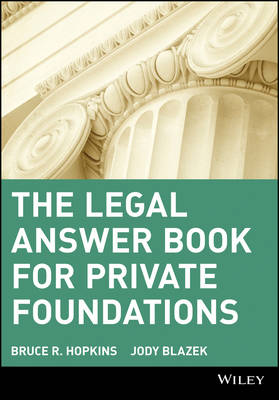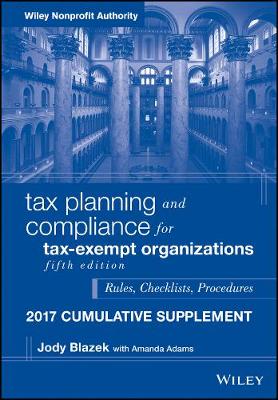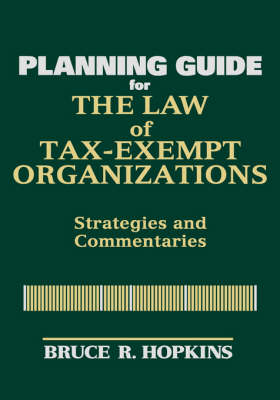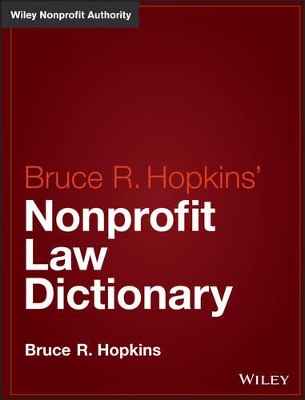Wiley Nonprofit Law, Finance and Management
5 primary works • 7 total works
Book 51
Book 164
The Legal Answer Book for Private Foundations
by Bruce R. Hopkins and Jody Blazek
Book 191
Blazek is widely recognized for her ability to translate complicated concepts into understandable language and explain the why and how Forms 990 should be prepared. In this book, readers will find: Comprehensive, fill-in forms with line-by-line instructions including a synopsis of applicable tax issues Explanation of consequences of answers that can have several consequences Suggestions for dealing with the IRS as an organization grows and changes Ways to maximize deductions in calculating tax due on unrelated business income Tips for successful navigation of the interactive parts of Form 990-PF and reducing excise tax
Book 211
Tax rules and regulations change annually, and nonprofit organizations know that staying compliant means staying up to date. But wading through tax code is less than helpful in the field, whereas the clear, practically oriented instruction inside provides the quick reference accountants, lawyers, and executives need. In the latest edition of Tax Planning and Compliance for Tax-Exempt Organizations, you'll find straightforward information on changing Unrelated Business Income (UBI) rules, joint ventures, sponsorships, deductions against UBI, preparation of IRS forms, and more.
Nonprofit organizations—including health and welfare organizations, colleges and universities, private foundations, churches, libraries, museums, cultural institutions, and other smaller groups—contend daily with the possibility of losing their tax-exempt status. From qualifying and applying for that status, to maintaining and managing it, every nonprofit organization must plan and monitor ongoing procedures, activities, and forms to comply with federal, state, and local regulations.
- Access easy checklists for reporting, compliance, eligibility, and more
- Examine sample bylaws, applications, and forms
- Utilize comparison charts and other visual aids for easy reference
- Review bullet lists that compare what is and what is not acceptable
Tax Planning and Compliance for Tax-Exempt Organizations is an indispensable guide to navigating the complex maze of nonprofit tax rules and regulations.
Book 216
The Planning Guide for the Law of Tax-Exempt Organizations
by Bruce R. Hopkins
Retirement Assets and Charitable Gifts
by Christopher R. Hoyt and Bruce R. Hopkins
The Bruce R. Hopkins Nonprofit Law Dictionary is a thorough professional reference for the terminology and definitions surrounding the law of tax-exempt organizations. Author Bruce R. Hopkins, the country's leading expert in nonprofit law, draws upon 45 years of practice to deliver a true dictionary reference for attorneys specializing in nonprofit law and tax law. The book's terminology and definitions are derived from constantly changing statutes, government agency regulations and rulings, court opinions, and government forms and instructions, with citations provided where appropriate. Modeled after a conventional dictionary, this book offers quick navigation to the information of interest, and points you toward the other Hopkins guides that provide more in-depth information should you require it.
The devil is in the details, and nowhere is that statement truer than in the legal profession. Incorrect interpretation of a single phrase can cause consequences for both client and attorney, and verbiage may be intentionally vague with unexpectedly broad or narrow definitions. This guide gives you the most commonly accepted interpretations of terminology related specifically to nonprofit law, so you can feel confident in the quality of service you provide to your clients.
- Stay up to date on the latest in nonprofit law
- Confirm the accepted definitions of legal terms and phrases
- Learn where to turn for deeper guidance on specific topics
- Gain expert insight into obscure and complex definitions
Stop spending time wading through textbooks and case law, only to wonder whether or not the information you eventually found applies to nonprofit law in the same way. Focused specifically on the law as it applies to the nonprofit sector, the Bruce R. Hopkins Nonprofit Law Dictionary is an indispensable reference that gives you the information you need quickly and easily.






